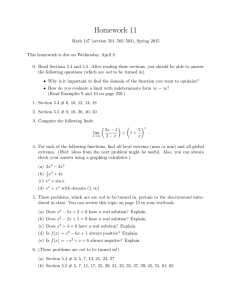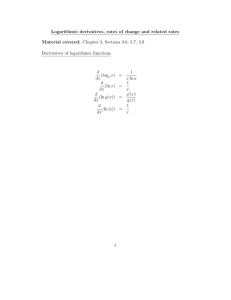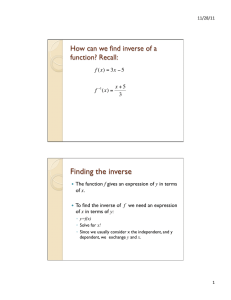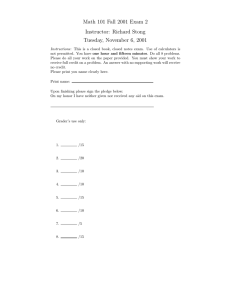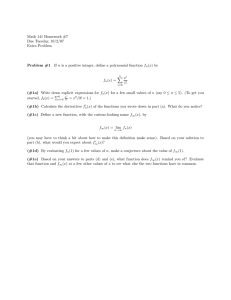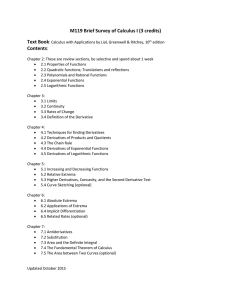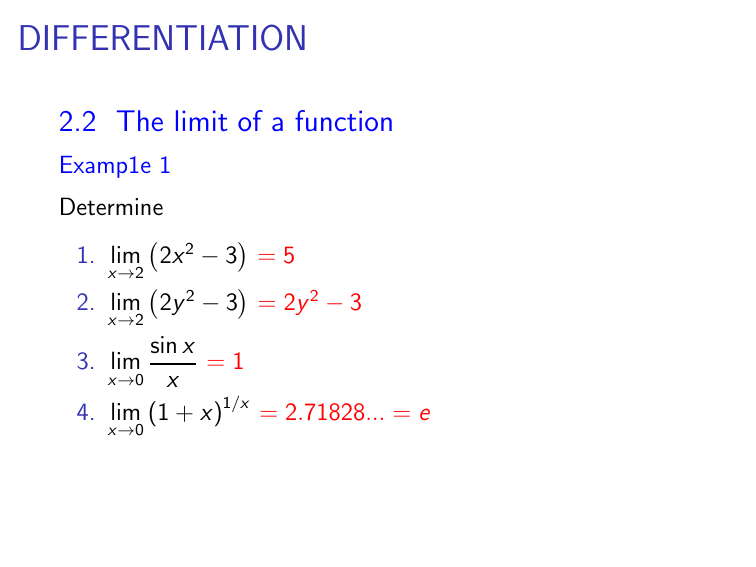
DIFFERENTIATION 2.2 The limit of a function Examp1e 1 Determine 1. lim 2x 2 − 3 = 5 x→2 2. lim 2y 2 − 3 = 2y 2 − 3 x→2 sin x =1 x→0 x 4. lim (1 + x)1/x = 2.71828... = e 3. lim x→0 2.3 Continuity Examp1e 2 Let f , g and h be functions defined by f (x) = cos x − x 5 , √ g (x) = x x, h(x) = sin x . x Answer the following and motivate your answer. 1. Is f continuous in 7? Yes. 2. Is g continuous in 4? Yes. 3. Is g continuous in 0? No, only right continuous, since g is not defined for negative real numbers. 4. Is g continuous in −3? No, g (−3) does not exist. 5. Why is h not continuous in 0? Can we extend the definition of h in order to be continuous every where? h(0) does not exist. Define h(0) = 1. 2.4 Rate of change Page 57: Average rate of change is an approximation of the instantaneous rate of change. Decreasing on the magnitude of h increases on the accuracy of the instantaneous rate of change. Take note that h may attain negative values as well. 2.5 The derivative of a function Page 59: Four steps in finding derivatives (instantaneous rate of change) Example 3 Find f ′ (4) if f (x) = 2x − x 2 . f ′ (4) = −6. Example 4 Find f ′ (x) if f (x) = 2x − x 2 . f ′ (x) = 2 − 2x. Example textbook p 62 2.6 Rules of differentiation Study Rules 1 to 6 in the textbook. Rule 7: The chain rule Example 5 Evaluate f g (x) , f ′ (x), g ′ (x) and f ′ g (x) if 1. f (x) = 2x and g (x)= x 2 . f g (x) = 2x 2 , f ′ (x) = 2, g ′ (x) = 2x, f ′ g (x) = 4x. 2. f (x) = x 2 and g (x) = 2x. f g (x) = 4x 2 , f ′ (x) = 2x, g ′ (x) = 2, f ′ g (x) = 8x. 3. f (x) = x 2 and g (x) = 2x − 6. f g (x) = 4x 2 − 24x + 36, f ′ (x) = 2x, g ′ (x) = 2, f ′ g (x) = 8x − 24. √ √ 4. f (x) = x and g (x) = x 3 − 1. f g (x) = x 3 − 1, f ′ (x) = 0.5x −0.5, g ′ (x) = 3x 2 . How do we calculate f ′ g (x) ? Here we have to use the chain rule. Example 6 Determine f ′ (x) for each of the questions in Example 5 using the chain rule. Nos. 1 – 3 are for homework. No. 4: Set √ dy dy du u = x 3 − 1 and y = f (u) = u. Then = · = dx du dx −0.5 0.5u −0.5 · 3x 2 = 1.5x 2 (x 3 − 1) . Exercise 10 page 74 dy = (x 2 − 7) (3x 2 + 10x + 9) + 2x (x 3 + 5x 2 + 9x) dx Exercises 17 page 74 Set g (x) = (1 + x) (1 + 2x − 3x 2 ) and h(x) = x − 4. g (x) dy g ′ (x)h(x) − g (x)h′ (x) Then y = and = = 2 h(x) dx h(x) h i 2 (1+x) (2−6x)+(1+2x −3x ) x − 4 − (1 + x) (1 + 2x − 3x 2) 2 x −4 2.7 Inverse functions and their derivatives Consider a one-to-one function f with domain [a, b] and range [c, d ]. Then the inverse function f −1 exists and y = f (x) ⇐⇒ x = f −1 (y ). The graphs of f and f −1 are symmetric about the line y = x. Example 7 Find the inverse function of f (x) = 2x − 4 and draw both df −1 df and . functions on the same system of axes. Find dx dx Set y = 2x − 4 (= f (x)) and write x in terms of y to find dx dy = 2 and = 0.5. x = 0.5(y + 4) = f −1 (y ). Then dx dy dy 1 df Note that = and that = 2. Reversing the dx (dx/dy ) dx role of x and y in x = 0.5(y + 4) = f −1 (y ), we may write y = 0.5(x + 4) = f −1 (x) and hence df −1 /dx = 0.5. Example 8 Find the inverse function of f (x) = x 2 − 4, where x ∈ (0, ∞) and draw both functions on the same system of axes. df −1 df and . Find dx dx Note that the domain of f ensures a one-to-one function. Set y = x 2 − 4 and write x in terms of y to find √ dy x = y + 4 = f −1 (y ). Then = 2x and dx dx = 0.5(y + 4)−0.5 . Note that dy dy 1 (dx/dy ) = 0.5/x = 1/(2x) and hence = . dx (dx/dy ) df Furthermore, = 2x. Reversing the role of x and y in dx √ √ x = y + 4 = f −1 (y ), we get y = x + 4 = f −1 (x)) and hence df −1 /dx = 0.5(x + 4)−0.5 . 2.8 Derivatives of special functions Alternative for Rules 9 and 10 d x (e ) = e x Rule 9(a): dx Rule 9(b): Note that ax = e x ln a . The chain rule yields d d x e x ln a (a ) = dx dx d = e x ln a (x ln a) dx x ln a = e (ln a) x = a ln a Rule 10(a): Rule 10(b): d e f (x) = e f (x) f ′ (x) dx d af (x) = af (x) f ′ (x) ln a dx Rule 11(a): d 1 ln x = dx x ln x . The chain rule yields ln a d d 1 (loga x) = ln x dx ln a dx 1 1 = ln a x Rule 11(b): Rule 12(a): Rule 12(b): Note that loga x = f ′ (x) d ln f (x) = dx f (x) ′ f (x) 1 d loga f (x) = dx ln a f (x) 2.9 Higher order derivatives Example 9 Find the following derivatives. 1. f (x) = e 2x , f ′′′ (x) = 8e 2x 2 − 2 ln v 2. g (v ) = (ln v )2 , g ′′ (v ) = v2 12 3. h(y ) = ln y 2, h(4) (y ) = − 4 y d 2 4. z(t) = e t log10 t, z(t) = 0 dx Example 10 A 350 kg motorcycle moves on a straight road according to the relationship x = 1.4t 3 + 5t, where x denotes distance in m and t time in s. 1. Calculate its speed after 3 seconds. 2. If it hits a concrete wall after 3 seconds, what would the impact force be on the wall? Answer dx = 4.2t 2 + 5, hence at time t = 3 s, the speed is dt v (3) = 42.8 m/s (≈ 154 km/h). dv d 2x 2. a = = 2 = 8.4t, hence a(3) = 25.2 m/s 2 and the dt dt impact force is F = ma = 8.82 kN. 1. v = 2.10 Optimisation 2.10.1 Extreme values for single variable functions The critical values of a continuous function f defined on [a, e] are found 1. at the endpoints a and e, 2. at points p where f ′ (p) = 0 and 3. at points q where f ′ (q) is not defined. Refer to Figure 2.10.1 p 89; points b and d are typical for point p and d is a typical example for point q. Remarks ◮ ◮ ◮ The local maxima and minima (extreme values) form part of the list of critical values. Not all critical values are local extrema. The absolute extremes form part of the list of local extrema. Suppose c is a critical point of f with f ′ (c) = 0 and suppose f ′′ (c) exists. 1. If f ′′ (c) < 0, f (c) is a local maximum. 2. If f ′′ (c) > 0, f (c) is a local minimum. 3. If f ′′ (c) = 0, no conclusion can be drawn, and the behaviour of f ′′ in the point c must be investigated. The value f (c) may be ◮ ◮ ◮ a local minimum or a local maximum or not any one of the above mentioned options. Example 11 Find the absolute minimum and maximum of the function f , with f (x) = 2x 3 − x 2 − 2x + 1 and −1.2 ≤ x ≤ 1.2. 1. Step 1 Find all critical values 1.1 The values f (−1.2) = −1.496 and f (1.2) = 0.616 are critical values. 1.2 f ′ (x) = 0 ⇐⇒ 6x 2 − 2x − 2 = 0 ⇐⇒ x = 0.76759 or x = −0.43426 and the corresponding critical values are f (0.76759) = −0.21985 and f (−0.43426) = 1.51615. 1.3 There are no points q for which f ′ (q) does not exist. 2. Step 2 Identify local / relative extrema f ′′ (x) = 12x − 2 and 2.1 f ′′ (0.76759) = 7.21110 > 0 =⇒ f (0.76759) = −0.21985 is a local / relative minimum. 2.2 f ′′ (−0.43426) = −7.21110 < 0 =⇒ f (−0.43426) = 1.51615 is a local / relative maximum. 3. Step 3 Identify absolute extrema The absolute maximum is f (−0.43426) = 1.51615 and the absolute minimum is f (−1.2) = −1.496.
